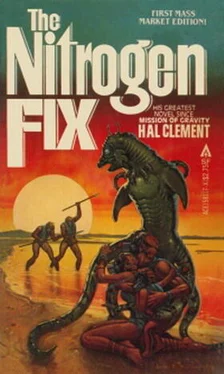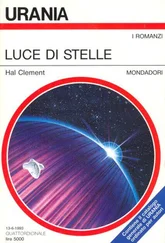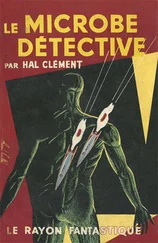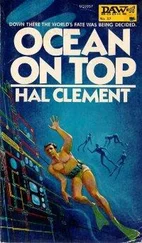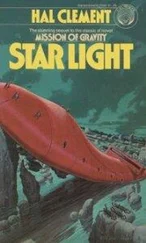Still close to the ground, she worked her way around to the south side of the jail. Then, keeping the structure between herself and the cargo pile, she half rose and ran as rapidly as she could southward and a little away from the water. This brought her gradually up the hillside, and presently the jail ceased to provide concealment.
However, the vegetation was thicker here, and she dropped back to the ground and crawled quickly straight up the slope. Once over the ridge and a short distance down the other side she felt safe in standing up, and after pausing a moment to get her breath she turned northward again.
Her path brought her fairly close to the fire site where Bones had been captured a few hours before, but very fortunately — her feet were unprotected — not near enough to feel its heat and be tempted into a real investigation.
Opposite the raft she approached the ridge again cautiously, travelling prone and exposing as little as possible of her head above it. Knowing that rapid motion was more likely to catch the human eye than any mere shape, she spent fully two minutes bringing her eyes to the level where she could see the raft and the cargo area.
The two Hillers were still at the latter place, working as they had been ordered. Even at three hundred meters distance and through the rather ripply mask glass they could be seen clearly enough. it was not possible to tell how much attention they were giving to other matters — how well, for example, they might be watching for Earrin — but her plan would take care of that anyway.
If she could carry it out. She had budgeted time for driving herself to the act, but as the eastern sky grew brighter she began to wonder whether she had allowed enough. It went against so many Nomad hangups. She was afraid of fire; it was dangerous and evil. It destroyed resources, both real-life and pseudolife which people needed for survival. It even destroyed structures, unless they were made of stone — and even those, if the stones were held by ordinary pseudolife cements. It even hurt, she knew, though she had never suffered a burn yet herself.
But these Hillers were a menace. They threatened the welfare and the lives of Kahvi herself, her husband, and her child, especially the child. If they got a good look at Kahvi they might even become a threat to the child still unborn; its presence was now reasonably obvious, though Kahvi’s figure was basically rather solid. The jailbird she had seen might already be aware of the newcomer. Worse, these people were oxygen-wasters, addicts, and therefore even less predictable and trustworthy than other Hillers.
And, after all, the fire wouldn’t actually hurt them. It wouldn’t even damage the jail, of course — if there had been risk of that, Kahvi could not have brought herself to start it under any circumstances. The jail was an oxygen haven, even with its present over oxygen concentration.
Having convinced herself again that this particular end was worth the proposed means — though still uneasy about it down inside — she worked her way back a few meters from the ridge and set to work.
Naturally the fire must not be allowed to spread any distance, so she tried to clear every single growth from a large radius and the recognizably explosive ones from an even greater distance around theproposed lighting spot. She was careful not to pile blasters on top of each other, covering them and separating them with less violent growths. By the time she was satisfied, the eastern sky was getting quite bright; there was little more time.
She worked more slowly and hesitantly now, however. Unfastening a couple of straps, she brought her breathing cartridges around in front, and disconnected one of them. It was a cylinder about the size of her forearm, with a valved hose extending from one end. The outer case had been made of “plastic” — a construction tissue of any sort grown by pseudolife — while the organ inside had been grown as a unit.
The oxygen-binder was a scion of one of the last forms of pseudolife to be designed before human culture lost the ability to produce such things from basic materials. Like most such “organisms” it was extremely stable genetically, though mutations sometimes occurred — more accurately cancers, since it was reproduced by culturing a fragment separated from the parent body.
Structurally it was a single-thickness sheet of cells so highly involuted that nearly all of them were exposed to the surroundings; the area within the unit totalled many hundreds of square meters.
The cells contained an oxygen binding complex similar to, but far more efficient than, hemoglobin; its equilibrium oxygen pressure was about a quarter of a standard atmosphere, changing little through the usual temperature range.
The cartridge fed normally into a bellows-like arrangement intended to permit controlled mixing with ordinary air, now almost entirely nitrogen. The traces of nitrogen oxides in the atmosphere were not filtered out or separated in any other way; they were responsible for the short average life span of Nomads.
Kahvi had found a growth which had a more intimate mixture than most of nitrates and reducers-a sort of super blaster; once or twice she had seen it ignite from impact. This, of course, could not be counted on; the “real” nitro-life, unlike the artificial varieties, mutated almost constantly. Bones had remarked more than once that eating was an endless experiment, though the Nomads had not translated the gestures with just that word.
Kahvi hoped that in a jet of straight oxygen this bit of wood could be expected to fire on impact, though it had not done so in ordinary air when she broke off the branch. She found a smooth stone and placed it beside her spread-out woodpile.
Then, holding her breath to conserve the last lungful, she removed her mask and placed the delivery tube of the disconnected cartridge in her mouth.
The mask and rebreather bellows were still connected to each other and to the remaining oxygen cartridge. She turned the inside of the mask toward the stone, raised the stick, squeezed the bellows and stopped. She couldn’t do it. Everything in the way of memories and habit patterns which made Kahvi Mikkonen what she was ordered her arm to stop the swing. For a moment she knelt motionless; then she brought the bellows back to her face, let it fill, and breathed again-the tube from the other cartridge had only diffused oxygen to her mouth, not nearly fast enough to keep her alive for long. The cartridge tissue outgassed to equilibrium very rapidly, but there had to be somewhere for the gas to go. The bellows, diluting it with nitrogen, made a large difference.
“Experiment!” she muttered, using what her Surplus school teachers had regarded as the vilest of words. Then she clenched her teeth, thought of her home and family again, drew another deep breath of diluted oxygen, and tried again.
This time the paralysis came too late to stop the impact, though the blow was far less violent than she had meant. Sparks flew, and the end of the stick took on a crimson glow; she had her fire. She dropped the wood, and quickly replaced her breathing gear. Then, seeing the incandescence spreading rapidly to include the entire branch, she seized it by the still-cold end and threw it into the wood pile.
Then she fled, almost fainting.
It took several minutes for the spreading glow to reach any of the blaster plants, and she was well to the north before the first crimson flash illuminated the view and the accompanying heavy thud reached her ears. She promptly dropped flat again and wriggled toward the top of the ridge bringing her head up with as much care as before.
The people might not be so stupid as to look only at the fire. She was recovering her self-control,though she felt nauseated.
Читать дальше
